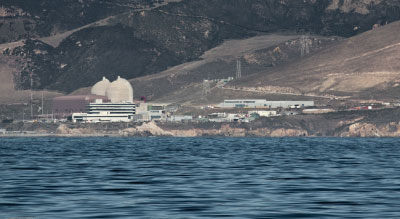
The reason for the visit was for some of our employees to see a nuclear reactor for the first time. What better place to do it than in our own backyard of San Luis Obispo, California? Home of Diablo Canyon Nuclear Power plant, and home to some controversy on its waste products, and what to do with them.
The tour, organized by the Diablo Canyon Independent Safety Committee (ISC), started out on a foggy morning at the PG&E Energy Education Center. The parking lot was full of colorfully dressed volunteers setting up for the AIDS life-cycle. This was one of their rest stops on the bikers’ long trek across California. The PG&E center had displays that showed different sections on electricity generation, nuclear power plants, nuclear fuel assemblies, solar panels, wind turbines, and electric vehicle charging stations.
We sat in on a presentation made and hosted by PG&E which talked about nuclear energy, the nuclear fuel cycle, and operations local to Diablo. The PG&E presentation was followed by an introduction of the ISC, their members, and the work that they do (impressive work, but more on that later).
After the presentations, we were led by the ISC and bussed to the power plant itself, a short drive away. We took a tour of the outside of the facilities, and even witnessed a safety drill done in their reactor simulator. Behind a one way mirror, we watched as reactor operators were being tested on determining failure modes of the reactor from an array of buttons and controls with a myriad of lights and monitors lit up across the room.
The apex of the visit for me was a short 30-second drive near the concrete dry-cask pad. The spent fuel was stored at a high-elevation above sea-level in approximately 50 Holtec canisters. This whole tour was a really great opportunity for our employees to learn, to see some real nuclear waste, to hear some of the concerns of citizens, and to see the infrastructure that goes behind a nuclear facility.
Following the exciting driveby was a short tour of their massive water intake system. Some people were concerned about the effects of the intake and outtake on sea life. The tour guides assured us that the intake posed no threat to larger fish and turtles with their barrier systems. The water coming from the outflow was warmer, and although it has made room for thermophilic algae to thrive, it has also pushed out the algae that was originally there.
One of the most interesting parts of the whole trip was to see how the community came together and created the Diablo Canyon Independent Safety Committee. The ISC was created in 1988 after a settlement agreement was established between the Division of Ratepayer Advocates of the California Public Utilities Commission (PUC), the Attorney General for the State of California, and Pacific Gas and Electric Company (PG&E). The committee consists of three nuclear professionals who are volunteers and who do not have any affiliation with the local utility and are responsible for auditing safety. The committee positions are held by Dr. Robert Budnitz of Lawrence Berkeley National Lab, Dr. Peter Lam who is an Administrative Judge Emeritus of the Nuclear Regulatory Commission and Dr. Per Peterson, Professor of Nuclear Engineering at the University of California, Berkeley. Coincidentally, Bob and Per are also advisors to Deep Isolation. The ISC has the right to receive operating reports and records from Diablo Canyon so that locals can be a part of the process of transparency and safety. Not that the nuclear power industry doesn’t already have a good safety record, but having more transparency with your local community can never hurt!
At the end of our tour, we were bussed back to the energy education center, and once again greeted by all of the colorful outfits adorned by the volunteers of the Aids Life Cycle. These people came together to fight for a common cause of public health and just plain helping people. This whole experience once again taught me that we can do amazing things when a whole community decides to work together.
